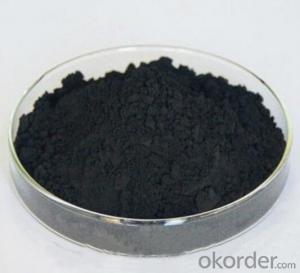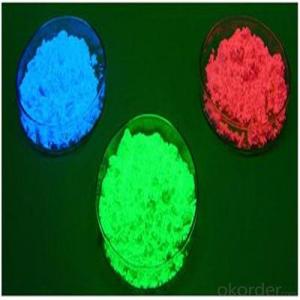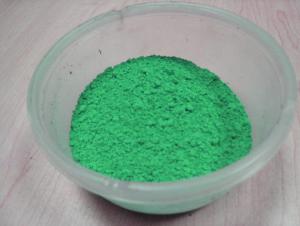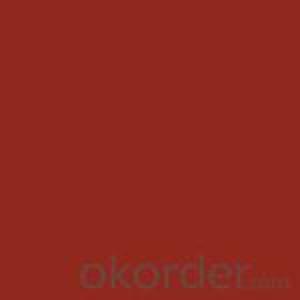Iron-titanium compound powder 808
- Loading Port:
- China Main Port
- Payment Terms:
- TT OR LC
- Min Order Qty:
- -
- Supply Capability:
- -
OKorder Service Pledge
OKorder Financial Service
You Might Also Like
Quick Details
Use: Suitable for aqueous, oily and various types of base materials to produce non (low)-toxic antirust paint, primer and integrated antirust paint. This product can completely or partly replace red lead antirust pigment.
Performance
1. Compared with other antirust paint, it has significantly improved dispersion property, stability, anti-sinking property and antirust performance.
2. 808 composite antirust pigment has obvious price advantage compared with other antirust pigments due to its low base material price.
3. Compared with red lead, 808 composite antirust pigment has much lower heavy metal content and is a new environmentfriendly product. It is easy to use by spraying or brushing, and is an ideal new antirust product to replace red lead.
Specifications
Technical index
Item Index Appearance Orange (yellow) powder Sieve residue (sieve mesh-400)%≤ 1 Density 27℃ g/cm3 3.0~4.2 Oil absorption g/100g ≤ 13~28 Water solubles g/100g ≤ 1 Volatile matter (105℃)%≤ 1 Aqueous suspension PH value 7.0~9.5 Phosphorus pentoxide% ≥ 30
Using method
Produce based on conventional antirust paint production process.
Recommended dosage
Recommended dosage is 20%-40%.
Packing
Double-layer plastic packaging, 25kg/bag - 40kg/bag.
Storage
Keep ventilated and dry, it can be stored for a year without deterioration
- Q: What does pigment mean?
- * PIGMENT [uncountable and countable] = a natural substance that makes skin, hair, plants etc a particular colour. ==> Melanin is the dark brown pigment of the hair, skin and eyes. ==> The artist Sandy Lee uses natural pigments in her work. ( Longman Dictionary ) * PIGMENT = the natural colouring matter of animal or plant tissue. ==> Carotenoid pigments are red, orange, or yellow. ( Oxford Dictionary ) * PIGMENT = a substance used for colouring or painting, especially a dry powder, which when mixed with oil, water, or another medium constitutes a paint or ink. ==> All the frescoes are painted with earth pigments ( Oxford Dictionary )
- Q: can the pigment know as Chinese purple form a matter wave in certain circumstances?
- Scientists explore atomic mysteries of ancient pigment LOS ALAMOS, N.M., Nov. 18, 2004 -- University of California scientists from the National High Magnetic Field Laboratory, Pulsed Field Facility at Los Alamos National Laboratory, working with colleagues from Tokyo Metropolitan University, the University of Buenos Aires in Argentina, the National Institute of Chemical Physics and Biophysics in Estonia, the National High Magnetic Field Laboratory in Tallahassee, Florida and the University of Tokyo, have discovered an ideal candidate for Bose-Einstein condensation in the ancient Chinese pigment, Han Purple. In research featured recently on the cover of Physical Review Letters, the team describes how the application of a strong magnetic field to Han Purple (BaCuSi2O6) creates a gas of bosonic spin triplet excitations. The field acts as a chemical potential causing the weakly interacting bosonic gas to undergo Bose-Einstein condensation (BEC) when the temperature is reduced to minus 453 degrees Fahrenheit, six orders of magnitude higher than the temperature normally required for BEC in atomic gases.
- Q: i would like to now so i could put it in a marker thanks..
- Isn't all ink pigmented? A quick search for make your own ink turned up many recipes. Here is one: Basic Permanent Black Ink: 1 egg yolk 1 tsp gum arabic 1/2 cup honey 1/2 tsp lamp black (buy in a tube or make by holding a plate over a lit candle) Mix egg yolk, gum arabic and honey in a small bowl.
- Q: what is the relationship between chlorophyll a, accessory pigment?
- Sativa- uplifting, high, trippy, baked out of your gourd, ****** up, spacy Indica- passing out, baked, stoned, sleepy, couchlock, retarded, weird dreams
- Q: Does albinism cause lack of ALL pigment, or just black pigment? Does this very on the species?
- Mammals and birds only have melanocytes (these produce varying amounts of brown or black pigment), so that's the only pigment that needs to be affected for them to display albinism. But other types of animals have multiple types of chromatophores. An albino snake, for example, would also need to have the cells that produce reds, yellows, and blues deactivated to appear white/colorless. For these animals to appear as albinos, all pigments would have to be affected.
- Q: whats it for? lol
- itz for ur beautifing ur skin.
- Q: why do plants need more than one pigment for light absorption?
- Pigments are molecules with an array of covalent bonds capable of absorbing a photon of light that has only a certain wavelength. The absorbed wavelength is only a fraction of the continuous range of wavelengths reaching the reaction center of a chloroplast. Each pigment species absorbs a different portion of the spectrum. So most photosynthesis works in combinations of pigments to absorb a across the visible spectrum and somewhat beyond. Some pigments (accessory photosynthesis carotenoid pigments) absorb useful wavelengths to pass the energy to chlorophyll A while the Xanthophyll Cycle pigments absorb potentially harmful high energy wavelengths for dissipation. Accessory pigments provide a range of spectra collection that allowed plants to adapt successfully to environments of differing light conditions. Pigments provide coloration to signal flower or fruit maturity to pollination partners or seed dispersal partners. Anthocyanins and carotenoids perform these communication functions. Phytochrome is a pigment that absorbs one wavelength only to toggle to another shape capable of absorbing at a different wavelength. Algae and plants both use this system to inform them of the time of year so they can synchronize with the best season in their habitat for reproduction efforts to succeed. Plants use phytochrome to regulate the photoperiod of flowering or seed germination.
- Q: what is the difference between light color and pigment colors?
- Pigments are chemicals that selectively absorb and reflect different spectra of light. When a surface is painted with a pigment, light hitting the surface is reflected, minus some wavelengths. This subtraction of wavelengths produces the appearance of different colors. Most paints are a blend of several chemical pigments, intended to produce a reflection of a given color.
- Q: is it the ink on regular printers?
- Some printers use only pigmented ink. Others use dye based and then some use a combination of both. Dye based ink is basically water based with a dye added to it. Pigmented ink has a solvent base with dye added. Pigment ink and dye based ink have both advantages and disadvantages. Dye based ink have better colors but pigment are more water and fade resistant. Dye based inks are therefore better for photos. I have a printer that has 4 dye based inks and a black pigment ink. Mine uses the dye based black and colours for pictures and the pigmented black is used for text. So the answer is yes. Pigmented ink is used in some regular printers.
- Q: So i'm writing up a lab report and i'm just a little confused on why scarlet, rosy, cinnabar and vermillion mutants contain the same kinds and amounts of pigments found in wild-type according to paper chromatography. Since they're mutants shouldn't it be different? I don't understand how i'm going to explain that they are mutants when it appears that they have the same phenotype as wild-type. Thank you so much for your help!
- Man pigments determine the colour of the eye. If the composition of pigments is same in all the flies,how can the colour in which their eyes look differ?isn't this a contradiction?i suspect the accuracy of The chromatography test because even a very very slight change in the amount of pigment can significantly change the colour. The phenotype is always different in mutants due to different genotype. in genotype is taken for granted if a change in phenotype is present. Wait just got over into a nice point. Sometimes even if the pigment composition being same different colours m8 be produced due to different allotropes or iro of the same pigment might have different colours!though allotropes(not isomers) have same composition but differ in,their post translational changes r different.since post translational changes r indirectly influenced by genes.this completely explains this case.
Send your message to us
Iron-titanium compound powder 808
- Loading Port:
- China Main Port
- Payment Terms:
- TT OR LC
- Min Order Qty:
- -
- Supply Capability:
- -
OKorder Service Pledge
OKorder Financial Service
Similar products
Hot products
Hot Searches
Related keywords






















